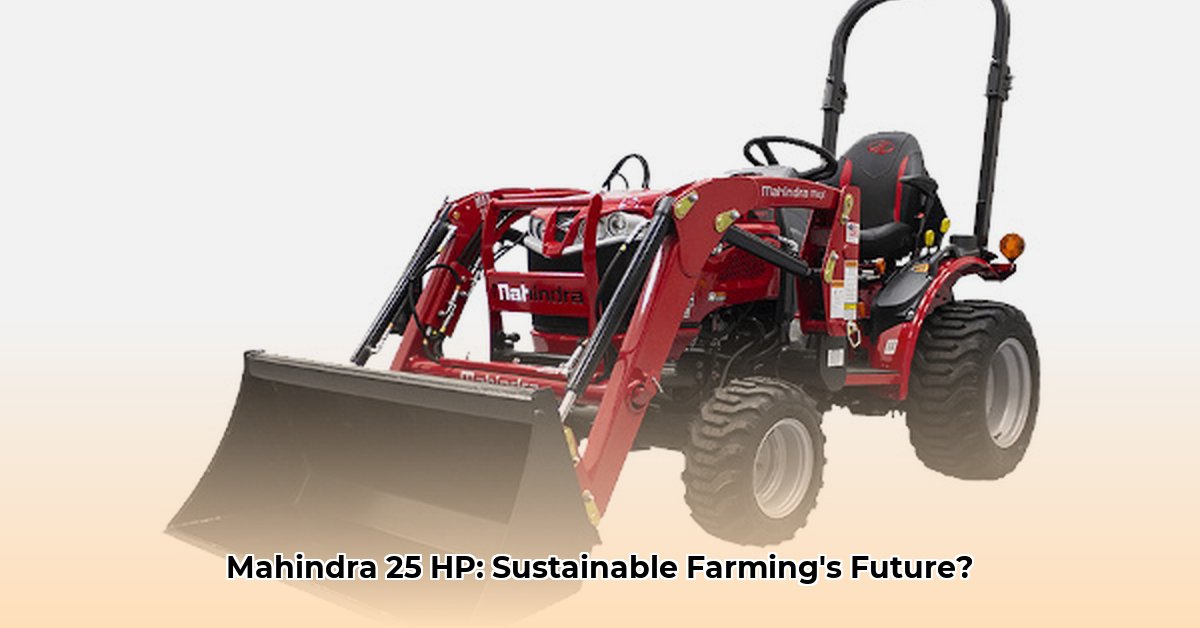
Sustainable farming practices are crucial for feeding a growing global population while protecting our planet. Farmers are increasingly seeking efficient and environmentally friendly tools, and the Mahindra 25 HP tractor is gaining attention. This article examines its role in sustainable agriculture, assessing its impact on farmers and the environment. For more information on Mahindra tractors, see this page.
The Mahindra 25 HP: Power and Efficiency Redefined
The Mahindra 25 HP tractor offers a compelling blend of power and fuel efficiency. But what does this really mean for farmers and the environment? To understand its true impact, we need detailed data on fuel consumption across various tasks (e.g., plowing, tilling, harvesting). A direct comparison to competing models, including a detailed analysis of their respective fuel efficiency and emissions profiles, is also critical for a comprehensive assessment. How does the Mahindra 25 HP stack up against the competition in terms of long-term cost-effectiveness and environmental impact? This nuanced comparison is key to providing farmers with actionable information.
Sustainability Beyond Horsepower: A Deeper Dive
While horsepower is a significant factor, true sustainability encompasses a broader scope. Does the Mahindra 25 HP truly deliver on its eco-friendly promises? We need independent verification of claims regarding sustainable materials used in its construction and the existence of manufacturer-led programs supporting sustainable agricultural practices amongst its users. This requires transparent data and third-party validation to build trust and ensure the tractor's environmental impact is accurately reflected.
Affordability and Accessibility: A Realistic Assessment
The Mahindra 25 HP’s price point is often cited as a key advantage. However, affordability is relative. A comprehensive analysis of the tractor's cost relative to average farmer income and typical operating expenses is necessary to determine its accessibility for smaller farms and farmers with limited resources. Is it truly a financially viable option for all farmers aiming for sustainability? Understanding this requires a detailed financial model incorporating diverse economic realities.
Farmer Voices: Real-World Success Stories
Real-world experiences are invaluable. Examining how farmers are using the Mahindra 25 HP to achieve their sustainability goals requires detailed case studies. These narratives should highlight the tractor's impact on fuel consumption, crop yields, and overall farming efficiency. For instance, a farmer might share how switching to a Mahindra 25 HP reduced their fuel bills by 15% while maintaining or improving crop yield. Such tangible examples demonstrate the tractor's practical value in the field.
Mahindra's mCRD Technology: A Green Revolution?
Mahindra's mCRD (common rail diesel) engine technology significantly reduces emissions compared to older models, meeting stringent EPA Tier 4 emission standards. This is achieved through optimized fuel combustion, minimizing unburnt hydrocarbons, and eliminating the need for a costly diesel particulate filter, resulting in lower maintenance costs. However, further investigation into the specific emission reductions achieved by the mCRD technology is needed, ideally supported by independent verification and comparative data against other engine technologies in the same class.
"The mCRD engine is a significant step forward in reducing the environmental impact of agricultural machinery,” says Dr. Amelia Hernandez, Professor of Agricultural Engineering at the University of California, Davis. "But it's only one piece of the puzzle. Sustainable farming requires a holistic approach."
Practical Steps to Minimize Your Tractor's Environmental Footprint
Beyond the engine technology, there are actionable steps farmers can take to reduce their tractor's overall environmental impact:
- Minimize Idle Time: Turning off the engine when not in use significantly reduces fuel consumption and emissions.
- Regular Maintenance: Keeping the tractor well-maintained ensures optimal engine performance, leading to improved fuel efficiency.
- Precision Farming Techniques: Utilizing GPS guided machinery and other precision techniques reduces wasted inputs, decreasing resource consumption and fuel use.
- Explore Biofuel Options: The transition to more sustainable biofuel alternatives, as they become viable, can further lessen your carbon footprint. This requires research into local availability and cost-effectiveness.
The Verdict: A Promising Tool, Needing Further Analysis
The Mahindra 25 HP tractor holds considerable potential for sustainable agriculture. However, more data are needed to fully assess its impact. Transparency regarding sustainability claims, along with robust comparisons to competing tractor models, is critical. This will empower farmers to make informed decisions that are both economically sound and environmentally responsible. The ongoing dialogue surrounding sustainable farming requires a continuous commitment to research and increased transparency from manufacturers. Further studies focusing on long-term environmental effects, cost-benefit analysis, and diverse farming contexts are essential.